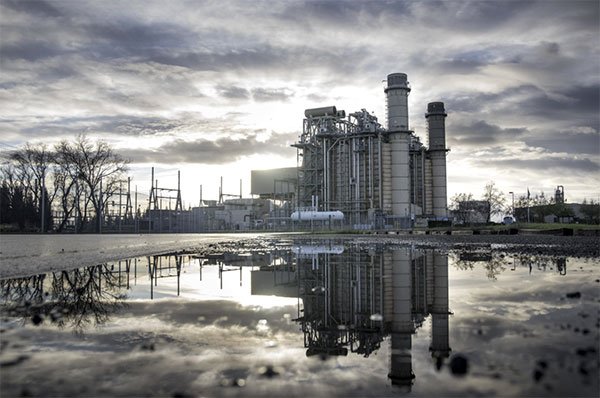The article below, published in the Los Angeles Times, demonstrates the need for a shift in our current energy system to better align the needs of California residents and businesses with the goals of energy providers. Currently, the main objective of private California utilities is to maximize shareholder profits. In the Community Choice Energy model, the core objective of a Community Choice Energy entity is to save rate payers money and provide clean energy. Please support the Community Choice Energy movement in any way that you can.
– Stacey Meinzen, The Climate Center
Californians pay a high price for electricity glut
By Ivan Penn and Ryan Menezes, LA Times
To cover the cost of new plants whose power isn’t needed, residents and businesses are paying billions more a year to switch on the lights.
YUBA CITY, Calif. — The bucolic orchards of Sutter County north of Sacramento had never seen anything like it: a visiting governor and a media swarm — all to christen the first major natural gas power plant in California in more than a decade.
At its 2001 launch, the Sutter Energy Center was hailed as the nation’s cleanest power plant. It generated electricity while using less water and natural gas than older designs.
A year ago, however, the $300-million plant closed indefinitely, just 15 years into an expected 30- to 40-year lifespan. The power it produces is no longer needed — in large part because state regulators approved the construction of a plant just 40 miles away in Colusa that opened in 2010.
Two other large and efficient power plants in California also are facing closure decades ahead of schedule. Like Sutter, there is little need for their electricity.
California has a big — and growing — glut of power, an investigation by the Los Angeles Times has found. The state’s power plants are on track to be able to produce at least 21% more electricity than it needs by 2020, based on official estimates. And that doesn’t even count the soaring production of electricity by rooftop solar panels that has added to the surplus.
To cover the expense of new plants whose power isn’t needed — Colusa, for example, has operated far below capacity since opening — Californians are paying a higher premium to switch on lights or turn on electric stoves. In recent years, the gap between what Californians pay versus the rest of the country has nearly doubled, to about 50%.
This translates into a staggering bill. Although California uses 2.6% less electricity annually from the power grid now than in 2008, residential and business customers together pay $6.8 billion more for power than they did then. The added cost to customers will total many billions of dollars over the next two decades, because regulators have approved higher rates for years to come so utilities can recoup the expense of building and maintaining the new plants, transmission lines and related equipment, even if their power isn’t needed.
How this came about is a tale of what critics call misguided and inept decision-making by state utility regulators, who have ignored repeated warnings going back a decade about a looming power glut.
“In California, we’re blinding ourselves to the facts,” said Loretta Lynch, a former president of the California Public Utilities Commission, who along with consumer advocacy groups has fought to stop building plants. “We’re awash in power at a premium price.”
California regulators have for years allowed power companies to go on a building spree, vastly expanding the potential electricity supply in the state. Indeed, even as electricity demand has fallen since 2008, California’s new plants have boosted capacity enough to power all of the homes in a city the size of Los Angeles — six times over. Additional plants approved by regulators will begin producing more electricity in the next few years.
The missteps of regulators have been compounded by the self-interest of California utilities, Lynch and other critics contend. Utilities are typically guaranteed a rate of return of about 10.5% for the cost of each new plant, regardless of need. This creates a major incentive to keep construction going: Utilities can make more money building new plants than by buying and reselling readily available electricity from existing plants run by competitors.
Regulators acknowledge the state has too much power but say they are being prudent. The investment, they maintain, is needed in case of an emergency — like a power plant going down unexpectedly, a heat wave blanketing the region or a wildfire taking down part of the transmission network.
“We overbuilt the system because that was the way we provided that degree of reliability,” explained Michael Picker, president of the California Public Utilities Commission. “Redundancy is important to reliability.”
Some of the excess capacity, he noted, is in preparation for the retirement of older, inefficient power plants over the next several years. The state is building many new plants to try to meet California’s environmental standards requiring 50% clean energy by 2030, he said.
In addition, he said, some municipalities — such as the Los Angeles Department of Water and Power — want to maintain their own separate systems, which leads to inefficiencies and redundancies. “These are all issues that people are willing to pay for,” Picker said.
Critics agree that some excess capacity is needed. And, in fact, state regulations require a 15% cushion. California surpasses that mark and is on pace to exceed it by 6 percentage points in the next three years, according to the Western Electricity Coordinating Council, which tracks capacity and reliability. In the past, the group has estimated the surplus would be even higher.
Even the 15% goal is “pretty rich,” said Robert McCullough of Oregon-based McCullough Research, who has studied California’s excess electric capacity for both utilities and regulators. “Traditionally, 10% is just fine. Below 7% is white knuckle. We are a long way from white-knuckle time” in California.
Contrary to Picker’s assertion, critics say, customers aren’t aware that too much capacity means higher rates. “The winners are the energy companies,” Lynch said. “The losers are businesses and families.”
The overabundance of electricity can be traced to poorly designed deregulation of the industry, which set the stage for blackouts during the energy crisis of 2000-2001.
Lawmakers opened the state’s power business to competition in 1998, so individual utilities would no longer enjoy a monopoly on producing and selling electricity. The goal was to keep prices lower while ensuring adequate supply. Utilities and their customers were allowed to buy electricity from new, unregulated operators called independent power producers.
The law created a new exchange where electricity could be bought and sold, like other commodities such as oil or wheat.
Everyone would benefit, or so the thinking went.
In reality, instead of lowering electricity costs and spurring innovation, market manipulation by Enron Corp. and other energy traders helped send electricity prices soaring.
That put utilities in a bind, because they had sold virtually all their natural gas plants. No longer able to produce as much of their own electricity, they ran up huge debts buying power that customers needed. Blackouts spread across the state.
State leaders, regulators and the utilities vowed never to be in that position again, prompting an all-out push to build more plants, both utility-owned and independent.
“They were not going to allow another energy crisis due to a lack of generation,” said Alex Makler, a senior vice president of Calpine, the independent power producer that owns the Sutter Energy plant not far from Sacramento.
But the landscape was starting to change. By the time new plants began generating electricity, usage had begun a decline, in part because of the economic slowdown caused by the recession but also because of greater energy efficiency.
The state went from having too little to having far too much power.
“California has this tradition of astonishingly bad decisions,” said McCullough, the energy consultant. “They build and charge the ratepayers. There’s nothing dishonest about it. There’s nothing complicated. It’s just bad planning.”
The saga of two plants — Sutter Energy and Colusa — helps explain in a microcosm how California came to have too much energy and is paying a high price for it.
Sutter was built in 2001 by Houston-based Calpine, which owns 81 power plants in 18 states.
Independents like Calpine don’t have a captive audience of residential customers like regulated utilities do. Instead, they sell their electricity under contract or into the electricity market, and make money only if they can find customers for their power.
Sutter had the capacity to produce enough electricity to power roughly 400,000 homes. Calpine operated Sutter at an average of 50% of capacity in its early years — enough to make a profit.
But then Pacific Gas & Electric Co., a regulated, investor-owned utility, came along with a proposal to build Colusa.
It was not long after a statewide heat wave, and PG&E argued in its 2007 request seeking PUC approval that it needed the ability to generate more power. Colusa — a plant almost identical in size and technology to Sutter — was the only large-scale project that could be finished quickly, PG&E said.
More than a half-dozen opponents, including representatives of independent power plants, a municipal utilities group and consumer advocates filed objections questioning the utility company. Wasn’t there a more economical alternative? Did California need the plant at all?
They expressed concern that Colusa could be very expensive long-term for customers if it turned out that its power wasn’t needed.
That’s because public utilities such as PG&E operate on a different model.
If electricity sales don’t cover the operating and construction costs of an independent power plant, it can’t continue to run for long. And if the independent plant closes, the owner — and not ratepayers — bears the burden of the cost.
In contrast, publicly regulated utilities such as PG&E operate under more accommodating rules. Most of their revenue comes from electric rates approved by regulators that are set at a level to guarantee the utility recovers all costs of operating the electric system as well as the cost of building or buying a power plant — plus their guaranteed profit.
Protesters argued that Colusa was unnecessary. The state’s excess production capacity by 2010, the year Colusa was slated to come online, was projected to be almost 25% — 10 percentage points higher than state regulatory requirements.
The looming oversupply, they asserted, meant that consumers would get stuck with much of the bill for Colusa no matter how little customers needed its power.
And the bill would be steep. Colusa would cost PG&E $673 million to build. To be paid off, the plant will have to operate until 2040. Over its lifetime, regulators calculated that PG&E will be allowed to charge more than $700 million to its customers to cover not just the construction cost but its operating costs and its profit.
The urgent push by PG&E “seems unwarranted and inappropriate, and potentially costly to ratepayers,” wrote Daniel Douglass, a lawyer for industry groups that represent independent power producers.
The California Municipal Utilities Assn. — whose members buy power from public utilities and then distribute that power to their customers — also complained in a filing that PG&E’s application appeared to avoid the issue of how Colusa’s cost would be shared if it ultimately sat idle. PG&E’s “application is confusing and contradicting as to whether or not PG&E proposes to have the issue of stranded cost recovery addressed,” wrote Scott Blaising, a lawyer representing the association. (“Stranded cost” is industry jargon for investment in an unneeded plant.)
The arguments over Colusa echoed warnings that had been made for years by Lynch, the former PUC commissioner.
A pro-consumer lawyer appointed PUC president in 2000 by Gov. Gray Davis, Lynch consistently argued as early as 2003 against building more power plants.
“I was like, ‘What the hell are we doing?’ ” recalled Lynch.
She often butted heads with other commissioners and utilities who pushed for more plants and more reserves. Midway though her term, the governor replaced her as president — with a former utility company executive.
One key battle was fought over how much reserve capacity was needed to guard against blackouts. Lynch sought to limit excess capacity to 9% of the state’s electricity needs. But in January 2004, over her objections, the PUC approved a gradual increase to 15% by 2008.
“We’ve created an extraordinarily complex system that gives you a carrot at every turn,” Lynch said. “I’m a harsh critic because this is intentionally complex to make money on the ratepayer’s back.”
With Lynch no longer on the PUC, the commissioners voted 5-0 in June 2008 to let PG&E build Colusa. The rationale: The plant was needed, notwithstanding arguments that there was a surplus of electricity being produced in the market.
PG&E began churning out power at Colusa in 2010. For the nearby Sutter plant, that marked the beginning of the end as its electricity sales plummeted.
In the years that followed, Sutter’s production slumped to about a quarter of its capacity, or just half the rate it had operated previously.
Calpine, Sutter’s owner, tried to drum up new business for the troubled plant, reaching out to shareholder-owned utilities such as PG&E and other potential buyers. Calpine even proposed spending $100 million to increase plant efficiency and output, according to a letter the company sent to the PUC in February 2012.
PG&E rejected the offer, Calpine said, “notwithstanding that Sutter may have been able to provide a lower cost.”
Asked for comment, PG&E said, “PG&E is dedicated to meeting the state’s clean energy goals in cost-effective ways for our customers. We use competitive bidding and negotiations to keep the cost and risk for our customers as low as possible.”
It declined to comment further about its decision to build Colusa or on its discussions with Calpine.
Without new contracts and with energy use overall on the decline, Calpine had little choice but to close Sutter.
During a 2012 hearing about Sutter’s distress, one PUC commissioner, Mike Florio, acknowledged that the plant’s troubles were “just the tip of the proverbial iceberg.”
He added, “Put simply, for the foreseeable future, we have more power plants than we need.”
Colusa, meanwhile, has operated at well below its generating capacity — just 47% in its first five years — much as its critics cautioned when PG&E sought approval to build it.
Sutter isn’t alone. Other natural gas plants once heralded as the saviors of California’s energy troubles have found themselves victims of the power glut. Independent power producers have announced plans to sell or close the 14-year-old Moss Landing power plant at Monterey Bay and the 13-year-old La Paloma facility in Kern County.
Robert Flexon, chief executive of independent power producer Dynegy Inc., which owns Moss Landing, said California energy policy makes it difficult for normal market competition. Independent plants are closing early, he said, because regulators favor utility companies over other power producers.
“It’s not a game we can win,” Flexon said.
Since 2008 alone — when consumption began falling — about 30 new power plants approved by California regulators have started producing electricity. These plants account for the vast majority of the 17% increase in the potential electricity supply in the state during that period.
Hundreds of other small power plants, with production capacities too low to require the same level of review by state regulators, have opened as well.
Most of the big new plants that regulators approved also operate at below 50% of their generating capacity.
So that California utilities can foot the bill for these plants, the amount they are allowed by regulators to charge ratepayers has increased to $40 billion annually from $33.5 billion, according to data from the U.S. Energy Information Administration. This has tacked on an additional $60 a year to the average residential power bill, adjusted for inflation.
Another way of looking at the impact on consumers: The average cost of electricity in the state is now 15.42 cents a kilowatt hour versus 10.41 cents for users in the rest of the U.S. The rate in California, adjusted for inflation, has increased 12% since 2008, while prices have declined nearly 3% elsewhere in the country.
California utilities are “constantly crying wolf that we’re always short of power and have all this need,” said Bill Powers, a San Diego-based engineer and consumer advocate who has filed repeated objections with regulators to try to stop the approval of new plants. They are needlessly trying to attain a level of reliability that is a worst-case “act of God standard,” he said.
Even with the growing glut of electricity, consumer critics have found that it is difficult to block the PUC from approving new ones.
In 2010, regulators considered a request by PG&E to build a $1.15-billion power plant in Contra Costa County east of San Francisco, over objections that there wasn’t sufficient demand for its power.
One skeptic was PUC commissioner Dian Grueneich. She warned that the plant wasn’t needed and its construction would lead to higher electricity rates for consumers — on top of the 28% increase the PUC had allowed for PG&E over the previous five years.
The PUC was caught in a “time warp,” she argued, in approving new plants as electricity use fell. “Our obligation is to ensure that our decisions have a legitimate factual basis and that ratepayers’ interest are protected.”
Her protests were ignored. By a 4-to-1 vote, with Grueneich the lone dissenter, the commissioners approved the building of the plant.
Consumer advocates then went to court to stop the project, resulting in a rare victory against the PUC. In February 2014, the California Court of Appeals overturned the commission, ruling there was no evidence the plant was needed.
Recent efforts to get courts to block several other PUC-approved plants have failed, however, so the projects are moving forward.
Times data editor Ben Welsh contributed to this report.


